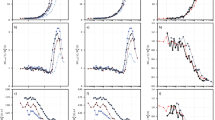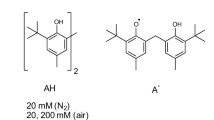Abstract
After many years of intense research, most aspects of the motion of entangled polymers have been understood. Long linear and branched polymers have a characteristic entanglement plateau and their stress relaxes by chain reptation or branch retraction, respectively. In both mechanisms, the presence of chain ends is essential. But how do entangled polymers without ends relax their stress? Using properly purified high-molar-mass ring polymers, we demonstrate that these materials exhibit self-similar dynamics, yielding a power-law stress relaxation. However, trace amounts of linear chains at a concentration almost two decades below their overlap cause an enhanced mechanical response. An entanglement plateau is recovered at higher concentrations of linear chains. These results constitute an important step towards solving an outstanding problem of polymer science and are useful for manipulating properties of materials ranging from DNA to polycarbonate. They also provide possible directions for tuning the rheology of entangled polymers.
This is a preview of subscription content, access via your institution
Access options
Subscribe to this journal
Receive 12 print issues and online access
$259.00 per year
only $21.58 per issue
Buy this article
- Purchase on Springer Link
- Instant access to full article PDF
Prices may be subject to local taxes which are calculated during checkout




Similar content being viewed by others
References
Rouse, P. E. A theory of the linear viscoelastic properties of dilute solutions of coiling polymers. J. Chem. Phys. 21, 1272–1280 (1953).
Doi, M. & Edwards, S. F. The Theory of Polymer Dynamics (Oxford Univ. Press, 1986).
Rubinstein, M. & Colby, R. H. Polymer Physics (Oxford Univ. Press, 2003).
De Gennes, P. G. Reptation of a polymer chain in a presence of fixed obstacles. J. Chem. Phys. 35, 572–579 (1971).
Doi, M. & Edwards, S. F. Dynamics of concentrated polymer systems. Part 1. Brownian motion in the equilibrium state. J. Chem. Soc. Faraday Trans. 2 74, 1789–1801 (1978).
De Gennes. Reptation of stars. J. Phys. France 36, 1199–1203 (1975).
Doi, M. & Kuzuu, N. Y. Rheology of star polymers in concentrated solutions and melts. J. Polym. Sci. C 18, 775–780 (1980).
McLeish, T. C. B. Hierarchical relaxation in tube models of branched polymers. Europhys. Lett. 6, 511–516 (1988).
McLeish, T. C. B. Polymers without beginning or end. Science 297, 2005–2006 (2002).
Robertson, R. M. & Smith, D. E. Strong effects of molecular topology on diffusion of entangled DNA molecules. Proc. Natl Acad. Sci. 104, 4824–4827 (2007).
Klein, J. Dynamics of entangled linear branched and cyclic polymers. Macromolecules 19, 105–108 (1986).
Rubinstein, M. Dynamics of ring polymers in the presence of fixed obstacles. Phys. Rev. Lett. 24, 3023–3026 (1986).
Nechaev, S. N., Semenov, A. N. & Koleva, M. K. Dynamics of a polymer chain in an array of obstacles. Physica A 140, 506–520 (1987).
Obukhov, S. P., Rubinstein, M. & Duke, T. Dynamics of a ring polymer in a gel. Phys. Rev. Lett. 73, 1263–1266 (1994).
Semlyen, J. A. (ed.) Cyclic Polymers 2nd edn (Kluwer, 2000).
Hild, G., Strazielle, C. & Rempp, P. Cyclic macromolecules—synthesis and characterization of ring-shaped polystyrenes. Eur. Polym. J. 19, 721–727 (1983).
Roovers, J. & Toporowski, P. M. Synthesis and characterization of ring polybutadienes. J. Polym. Sci. B 26, 1251–1259 (1988).
Roovers, J. & Toporowski, P. M. Synthesis of high molecular-weight ring polystyrenes. Macromolecules 16, 843–849 (1983).
Bielawski, C. W., Benitez, D. & Grubbs, R. H. An ‘endless’ route to cyclic polymers. Science 297, 2041–2044 (2002).
Roovers, J. Melt properties of ring polystyrenes. Macromolecules 18, 1359–1361 (1985).
McKenna, G. B., Hostetter, B. J., Hadjichristidis, N., Fetters, L. J. & Plazek, D. J. A study of the linear viscoelastic properties of cyclic polystyrenes using creep and recovery measurements. Macromolecules 22, 1834–1852 (1989).
Orrah, D. J., Semlyen, J. A. & Ross-Murphy, S. B. Studies of cyclic and linear poly(dimethylsiloxanes): 27. Bulk viscosities above the critical molar mass for entanglement. Polymer 29, 1452–1454 (1988).
McKenna, G. B. et al. Dilute solution characterization of cyclic polystyrene molecules and their zero-shear viscosity in the melt. Macromolecules 20, 498–512 (1987).
Roovers, J. in Current Topics in Polymer Science, Vol. II—Rheology and Polymer Processing/Multiphase Systems (eds Ottenbrite, R. M., Utracki, L. A. & Inoue, S.) (Hanser, 1987).
Roovers, J. Viscoelastic properties of polybutadiene rings. Macromolecules 21, 1517–1521 (1988).
McKenna, G. B. & Plazek, D. J. The viscosity of blends of linear and cyclic molecules of similar molecular mass. Polym. Commun. 27, 304–306 (1986).
Mills, P. J. et al. Diffusion of polymer rings in linear polymer matrices. Macromolecules 20, 513–518 (1987).
Pasch, H. & Trathnigg, B. HPLC of Polymers (Springer, 1997).
Lee, H. C., Lee, H., Lee, W., Chang, T. & Roovers, J. Fractionation of cyclic polystyrene from linear precursor by HPLC at the chromatographic critical condition. Macromolecules 33, 8119–8121 (2000).
Brown, S., Lenczycki, T. & Szamel, G. Influence of topological constraints on the statics and dynamics of ring polymers. Phys. Rev. E 63, 052801 (2001).
Muller, M., Wittmer, J. P. & Cates, M. E. Topological effects in ring polymers: A computer simulation study. Phys. Rev. E 53, 5063–5074 (1996).
Kawaguchi, D. et al. Comparison of interdiffusion behaviour between cyclic and linear polystyrenes with high molar masses. Macromolecules 39, 5180–5182 (2006).
Marrucci, G. Relaxation by reptation and tube enlargement: A model for polydisperse polymers. J. Polym. Sci. Polym. Phys. Ed. 23, 159–177 (1985).
Viovy, J. L., Rubinstein, M. & Colby, R. H. Constraint release in polymer melts: Tube reorganization versus tube dilation. Macromolecules 24, 3587–3596 (1991).
McLeish, T. C. B. Why, and when, does dynamic tube dilation work for stars? J. Rheol. 47, 177–198 (2003).
Fetters, L. J., Lohse, D. J. & Colby, R. H. in Physical Properties of Polymers Handbook 2nd edn (ed. Mark, J. E.) (Springer, 2006).
Obukhov, S. P., Rubinstein, M. & Colby, R. H. Network modulus and superelasticity. Macromolecules 27, 3191–3198 (1994).
Koniaris, K. & Muthukumar, M. Knottedness in ring polymers. Phys. Rev. Lett. 66, 2211–2214 (1991).
Orlandini, E. & Whittington, S. G. Statistical physics of closed curves: Some applications in polymer physics. Rev. Mod. Phys. 79, 611–642 (2007).
Grosberg, A. Y. Critical exponents for random knots. Phys. Rev. Lett. 85, 3858–3861 (2000).
Moore, N. T. & Grosberg, A. Y. Limits of analogy between self-avoidance and topology driven swelling of polymer loops. Phys. Rev. E 72, 0161803 (2005).
Zoller, P. & Walsh, D. Standard Pressure-Volume-Temperature Data for Polymers (Technomic, 1995).
Ferry, J. D. Viscoelastic Properties of Polymers 3rd edn (Wiley, 1980).
vanRuymbeke, E., Kapnistos, M., Vlassopoulos, D., Huang, T. & Knauss, D. M. Linear melt rheology of pom–pom polystyrenes with unentangled branches. Macromolecules 40, 1713–1719 (2007).
Cates, M. E. & Deutsch, J. M. Conjectures on the statistics of ring polymers. J. Phys. (Paris) 47, 2121–2128 (1986).
Iyer, B. V. S., Lele, A. K. & Shanbhag, S. What is the size of a ring polymer in a ring-linear blend? Macromolecules 40, 5995–6000 (2007).
Isichenko, B. Percolation, statistical topography, and transport in random media. Rev. Mod. Phys. 64, 961–1043 (1992).
Acknowledgements
We are indebted to J. Roovers for providing the original ring polymers used in this work and for many insightful discussions. We are particularly grateful to S. T. Milner and T. C. B. McLeish for extended discussions that clarified the role of constraint release and significantly improved the quality of the paper. We thank S. Panyukov, S. P. Obukhov, N. Hadjichristidis, B. Loppinet, E. van Ruymbeke, G. Fytas, A.Y. Grosberg, C. Tsenoglou and M. Vamvakaki for helpful discussions. This work was supported by EU (NoE Softcomp NMP3-CT-2004-502235), NSF (CHE-0616925, CBET-0609087), NIH (1-R01-HL0775486A) and KOSEF (CIMS, R0A-2007-000-20125-0).
Author information
Authors and Affiliations
Corresponding authors
Rights and permissions
About this article
Cite this article
Kapnistos, M., Lang, M., Vlassopoulos, D. et al. Unexpected power-law stress relaxation of entangled ring polymers. Nature Mater 7, 997–1002 (2008). https://doi.org/10.1038/nmat2292
Received:
Accepted:
Published:
Issue Date:
DOI: https://doi.org/10.1038/nmat2292



